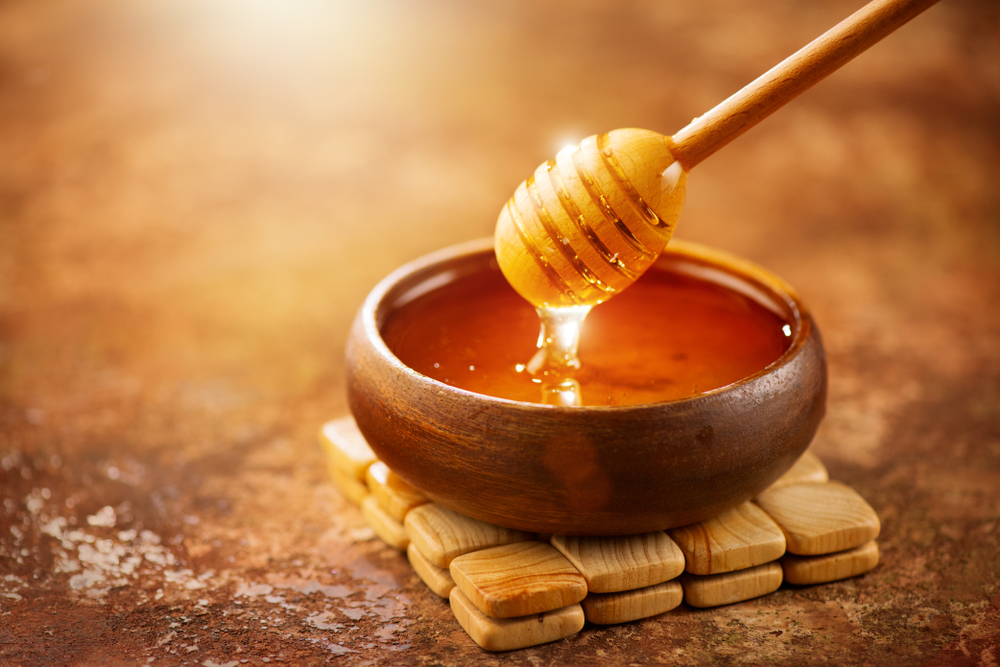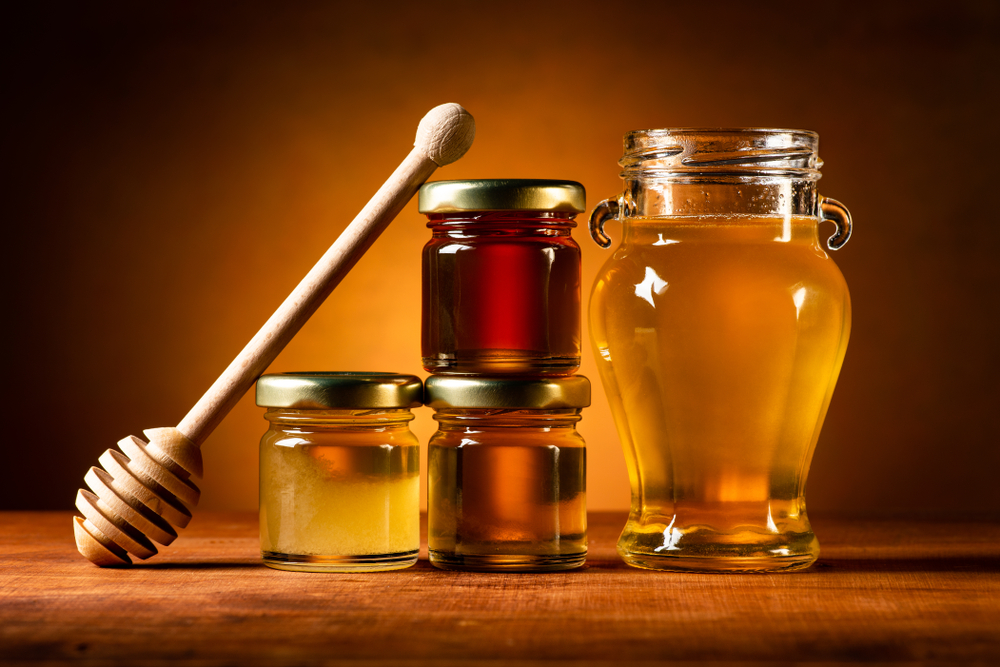This post may contain affiliate links.
Honey is one of the most remarkable foods on earth. It’s the only commonly consumed food made from an insect. It also has a deep history, traditionally used as food, medicine, and symbolically in many cultures.
Although there are many types of honey, there are 10 common types widely available to us today. There are many different ways to use these different types of honey, and some are better for certain applications (like in the kitchen or as beauty treatments).
Today, we’ll explore everything you need to know about honey. Where does it come from? What are the common uses of honey? And where can you find each type of honey to explore and experiment?

Getting to Know Bee Basics
There are over 20,000 species of bees in the world, including carpenter bees and sweat bees. Bees belong to the same order as ants, wasps, and similar insects. The European honeybee is the most ubiquitous bee in North America and is primarily used in apiculture—otherwise known as honey production.
Apiculture or backyard beekeeping has become more popular over the last decade. Homesteaders and hobby farmers often like to include hives on their property. It makes a lot of sense, considering the many benefits of these pollinators. They help crops flourish, produce honey, and are a vital part of the ecosystem. Bees are responsible for pollinating 1 in every 3 bites of food we eat.
What’s more, bees are under threat due to disease, climate changes, and pesticides. Beekeepers play a vital role in ensuring that bee colonies stay healthy and thrive in today’s world. By caring for these important little creatures, they’re ensuring that we will continue to have pollinators in the future.
Inside the bees’ colony, there’s a hustle and bustle of activity. A healthy colony of bees includes a queen, an unbelievable 20,000-80,000 worker bees, and a small number of drones (male bees) and maiden queens, depending on the season. The queen lives up to five years and lays up to 1500 eggs per day.
The smaller female worker bees live for about six weeks, during which they do a tremendous amount of work. From raising the young bees to taking care of the hive and guarding it against attack or pillaging, these female bees are the workforce of the colony’s world. The worker bees forage for nectar, which they will later turn into honey. They calculate the distance and the locations for the most effective foraging.
Each worker bee performs many duties around the hive, but the honey-making process is one of the most critical. If you’ve ever wondered how honey is made, it starts as nectar collected by the worker bees. Then, they carry the nectar to the hive and store it within the pockets of the honeycomb. The honeycomb is made from beeswax, and bees create it in amazing hexagonal shapes. Each wax pocket holds a small amount of nectar, which reacts with the wax, along with the waving of the bees’ wings, and evaporates into thick, sweet honey.
Honeybees learn which flowers produce the right nectar for making honey. While they fly from flower to flower, pollen collects on their legs and bodies, pollinating flowers as they go. Bees are responsible for pollinating $14.6 billion in agriculture across the United States. The bees do this massive job by sharing information about nectar sources, quantity, and quality with the rest of their hive. They communicate with each other by “dancing.” (You can see a bee dance here.) Bees are intelligent creatures and even engage in associative learning with color for navigating.
A honeybee must gather nectar from around two million flowers to make just one pound of honey. The average bee makes only 1/12th a teaspoon of honey during its lifetime. Fortunately, with up to 80,000 bees in a hive, each small contribution adds up. It’s the strength in numbers that make it possible to produce honey on such a large scale.
When it’s time to harvest honey, beekeepers scrape the honeycomb frames in the beehives to remove the wax caps that cover the end of each section of the honeycomb. For large-scale operations, a centrifuge is used to extract all the delicious, sweet honey from the frames. Once the frames are clean, they are placed back into the hive so that bees can continue their work. The beekeepers then bottle and sell the honey for many different uses.

The History of Honey
Honeybees have been producing honey in the same way for about 150 million years, and we as human beings have certainly learned to capitalize on it. Archaeologists have found evidence of prehistoric beekeeping from 9,000 years ago, including traces of beeswax on pottery. Cave paintings depicting apiculture were also found, dating back to prehistoric times. Honey has been used as food, sweetener, medicine, beauty treatments, and even religious offerings throughout history.
Our ancient ancestors knew that honey is an incredible substance with many different benefits (not just for sweetening tea and spreading on toast). Since ancient times, honey has been thought to help with many different issues, including sore throats, asthma, allergies, diabetic ulcers, digestive disorders, skin problems, and more. It was used as first aid for dressing wounds, treating burns, and healing cuts. Different types of honey and honey-related products (like royal jelly) can help with a myriad of different ailments.
Honey has antiseptic properties and is highly shelf-stable. It can last for many years without ever spoiling. Thanks to the high acid content, antiseptic aspects, and low-moisture content (even though it’s a liquid), honey can last for decades or more. Some of the oldest honey was found in Egyptian tombs over 3000-years-old, and 5000-year-old honey was found in the country of Georgia amongst archeological ruins. While that honey might not be edible to most of us, it’s safe to say that the honey in your pantry will last a very long time.
Today, honey is used in many different ways. Primarily we think of honey as a sweetener, using it in tea or baked goods. As an energy food, the natural fruit sugars in honey—fructose and glucose—are quickly digested by the body, making it ideal for athletes needing a natural energy boost.
Honey is hygroscopic—it can pull moisture from the air and hold onto it. This is thanks to the high sugar content that gives honey its sweetness. Honey’s ability to attract and retain moisture means that it has long been used as a beauty treatment. Whether honey is used as a facial mask, moisturizer, ingredient in a body scrub, or an exfoliant, honey is an excellent beauty tool. Historically, it was a significant part of Cleopatra’s daily beauty ritual.
As food, honey, especially in its raw form, is incredibly healthy and includes enzymes, vitamins, and minerals all good for the human body. It’s one of the few sources of “pinocembrin,” a flavonoid that has shown promise in drug studies for treating cardiovascular disease and some neurodegenerative disorders.
With these fantastic properties, it is no wonder we have developed so many ways to use the different types of honey. It goes above and beyond the role of a tasty treat!
10 Types of Honey to Try
Believe it or not, there are many types of honey. Although you may think of honey as simply the sweet substance in that cute little squeeze bear in the cupboard, there are all sorts of forms to try. Here’s a breakdown of the 10 types of honey you should check out today!
1. Jarred Honey
When you think of the types of honey, the jarred variety is probably what comes to mind first. Honey in the jar is versatile! You can use this type of honey in cooking, baking, and as a spread on bread. Jarred honey works wonderfully in hot drinks like tea.
In the store, you’ll usually find two types of jarred honey—monofloral and polyfloral. Monofloral honey comes from one plant. You might see star thistle, orange blossom, clover, or other monofloral varieties. You’ll notice that they have subtle differences in both taste and aroma.
Polyfloral honey is usually labeled “wildflower” honey and contains a variety of different nectars. Because of the variety of sources, polyfloral honey can contain different trace vitamins and minerals. Some polyfloral honeys are thought to have more antioxidant properties than certain monofloral types.
2. Honeydew Honey
Honeydew honey is primarily derived from the sweet secretions (or honeydew) of aphids and other plant-sap-feeding insects picked up by bees rather than pollen. The bees may pick up the honeydew from specific plants or at certain times of the day. This type of honey is typically very dark brown. It’s favored in Europe and New Zealand because of the rich, flavorful aspects. It is higher in antioxidants and nutrients than some other types of honey.
Beekeepers raising bees that produce honeydew honey must be wary. Because the honey contains high amounts of ash, it can be dangerous for the bees and cause bee dysentery. As a result, beekeepers often clear the hives of honeydew honey before the bees settle in for the winter months.
This type of honey is expensive and harder to come by in the states, although certain regions like California may have local honeydew honey available. If you find some, it’s definitely worth trying. The flavor is different, less acidic, and somewhat more robust than other types of honey.
3. Crystalized or Candied Honey
Anyone who’s left their honey in the cupboard for a while has probably run into crystallized honey. Raw honey is particularly prone to crystallization. You can also find crystalized or candied honey available for purchase. When honey sits, it solidifies into a crystal-like state. You can turn it back into liquid by warming it gently, and it will become the same golden liquid you’re used to.
But crystallized honey can also be useful in the hardened form. You can swap it for sugar in baking, use it to add texture on top of yogurt, cake, oatmeal, or fruit, or you can use crystal honey in drinks. In the crystal form, honey could be used as a scrub or in skincare applications as well. Keep in mind that the crystals will dissipate if the honey is warmed, so keep it cool if you want to keep the great crunchy consistency.
4. Pasteurized Honey
Most honey at the store has been pasteurized. Pasteurization means that the substance (like milk, or in this case, honey) was exposed to high temperatures to destroy yeast cells and pathogenic organisms. In many cases, the process helps to delay spoilage and gives the product a longer shelf-life. In the case of honey, it delays the onset of crystallization, making it shelf-stable.
You might be asking if pasteurization is necessary. In the case of honey, pasteurization is done for texture, not preservation. As mentioned before, honey doesn’t spoil thanks to its acidity, low humidity, and antibacterial properties. So, the pasteurization process can also cause the deterioration of product quality and break down the molecular structure of helpful enzymes.
Is pasteurized honey bad? Not at all. It’s probably the type you’ll find at the local grocery store. The flavor is often mild because it doesn’t have the added yeast and other organisms. However, some people believe that the process reduces the antioxidants, and some producers add additional sugars to heighten the sweetness.
5. Raw Honey
Raw honey is honey in the purest form. It’s the honey that comes right out of the beehive, and it’s extracted without adding heat or processing the honey. Producers will usually filter the honey before bottling to remove pieces of honeycomb, pollen, and other debris. But you can sometimes find raw honey with chunks of honeycomb in-tact (check the shelves of your local health food store).
Raw honey is the most healthful type of honey, in my opinion. It’s also the tastiest! There’s a wonderful strong taste to the honey, and you’ll notice different flavors depending on the origins. For example, raw honey in the Southern United States will taste quite different than honey from the Pacific Northwest. It can be fun to try these different types of honey to see what tastes best.
Many people feel that raw honey contains the most beneficial nutrients and antioxidant properties as well. Allergy sufferers often experiment with raw, local honey to find relief from seasonal allergies. A word of caution, however—you should avoid raw, unprocessed honey if you have a sensitivity to bees or bee stings. It’s rare, but some people can react to the debris from the bees that may still be in the raw honey.
6. Creamed or Whipped Honey
Creamed honey is delicious and really different texture-wise. It has a much creamier mouthfeel that some people prefer. Apiculturists process the honey slowly, adding in crystallized honey to create a honey that’s creamy, spreadable, and delicious. Creamed honey will stay uncrystallized—it never gets hard like other types of honey.
Some producers add different herbs and spices to the creamed honey to make varieties such as cinnamon or vanilla. The creamed honey is excellent on bread and crackers. Despite the name, it’s important to note that it doesn’t contain dairy.
Creamed honey can be especially soothing to sore throats when added to tea. People also like to use creamed honey in cosmetic applications thanks to the softer texture.
.

7. Ultrasonicated Honey
Another type of honey is ultrasonicated honey. In this case, the honey goes through an ultrasonication process, which sounds very futuristic. The honey is exposed to a non-thermal ultra-sonic procedure that kills most yeast cells and delays crystallization.
Ultrasonicated honey provides an alternative to pasteurized honey. You still get mostly yeast-free honey while simultaneously retaining the essential nutrients. The taste, texture, and aroma of ultrasonicated honey remain close to raw. Although this type of honey is harder to find, it can be an excellent alternative to those who are concerned about the yeast but still want to enjoy the nutrients of unpasteurized honey.
8. Comb Honey
Comb honey is another version of raw honey, still found in the original beehive combs. Not only is comb honey beautiful, but it can be great for teaching kids about apiculture. It’s quite fascinating to see the rows of perfectly formed honeycombs.
Comb honey contains the waxy honeycomb, making it an interesting option for homemade cosmetic and beauty applications. It also looks beautiful as part of a charcuterie platter or included on a holiday table. The honeycomb serves as a nice reminder of where our food originates and our connection to the environment.
9. Royal Jelly
Royal jelly is honey secreted by worker bees and fed to young bees during development. They also feed it in large amounts to the developing future queen bees. The protein royalactin plays a role in bee development—determining if a bee becomes a worker or a queen.
For human use, royal jelly is a dietary supplement known for being high in B-complex vitamins. It’s used in beauty applications because of the antiaging properties of amino acids and the broad spectrum of vitamins and minerals. You’ll see it listed as an ingredient in many different products, but you can find pure royal jelly too. There is promising research on the application of royal jelly in many diseases and illnesses.
If you’d like to try royal jelly, I recommend Greenbow Organic Royal Jelly. It’s certified organic and suitable for use as a supplement.
10. Mānuka Honey
Manuka honey is a type of honey produced by European honeybees from the nectar of the tea trees in New Zealand and Australia. The honey is distinctively different from the more common types of honey found throughout Europe and the Americas due to its high viscosity, darker brown color, and very earthy or herbaceous flavor.
Manuka honey has been identified in clinical studies for its antibacterial properties. Although other honeys have similar properties, Manuka is at least 70% sourced from the tea tree plant, whose medicinal properties are already well-known. The tea tree plant also gives it a distinctive flavor.
If you’re interested in trying Manuka honey, I recommend Wedderspoon Premium Manuka. I’d love to hear your thoughts on the flavor and performance of this interesting type of honey.
Which Type of Honey is Best?
Well, honestly, it depends on what you want to use it for. Although I recommend raw honey over pasteurized versions, honey in all its different forms can be useful. If you’re going to eat it as a treat, honeycomb is great! As a replacement for sugar in baking, honey out of the jar or crystallized honey can work well. As a spread on bread or a soothing additive for your tea, creamed honey is an excellent choice.
Honey is a truly incredible food with many relevant and unique properties associated with it. With a long history of use as medicine, food, and a beauty product, honey’s popularity will likely continue for years to come.
If we love honey, it’s essential to recognize the news that honeybees around the world (particularly in North America) have been in decline due to the effects of pesticides, monoculture in agribusiness, and illnesses (like Colony Collapse Disorder).
As home gardeners, there are ways we can help support bees in our community. We can provide a stable food supply throughout the year by including bee-friendly plants in our gardens. Stagger plantings when possible to ensure different flowers bloom throughout the year. Include wildflower mixes (look for non-GMO and non-invasive varieties) that can appeal to the preferences of your native bees. Not only do these (often perennial) plants look great, but they’re often highly tolerant of your local conditions, making them easy to grow.
If we look out for bees, they will continue to give back to us.
I hope his exploration of the different types of honey and their uses has been tastily informative. In the comments, let me know what you like to do with honey!
~Charlene







